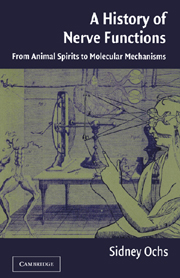Book contents
- Frontmatter
- Contents
- Preface
- 1 Introduction: Greek Science and the Recognition of Nerve as a Channel
- 2 Galen's Physiology of the Nervous System
- 3 Nerve, Brain, and Soul in the Middle Ages
- 4 Renaissance and the New Physiology
- 5 New Physical and Chemical Models of Nerve in the Enlightenment
- 6 New Systematizations of Nerve Function in the Enlightenment
- 7 Electricity as the Agent of Nerve Action
- 8 Nerve Fiber Form and Transformation
- 9 Wallerian Degeneration: Early and Late Phases
- 10 Nerve Regeneration
- 11 Characterization of Axoplasmic Transport
- 12 Molecular Models of Transport
- 13 Actions of Neurotoxins and Neuropathic Changes Related to Transport
- 14 Purposeful Reflexes and Instinctive Behavior
- 15 Neural Events Related to Learning and Memory
- 16 Epilogue: With Observations on the Relation of the Nervous System to Mind
- Bibliography
- Index
8 - Nerve Fiber Form and Transformation
Published online by Cambridge University Press: 13 August 2009
- Frontmatter
- Contents
- Preface
- 1 Introduction: Greek Science and the Recognition of Nerve as a Channel
- 2 Galen's Physiology of the Nervous System
- 3 Nerve, Brain, and Soul in the Middle Ages
- 4 Renaissance and the New Physiology
- 5 New Physical and Chemical Models of Nerve in the Enlightenment
- 6 New Systematizations of Nerve Function in the Enlightenment
- 7 Electricity as the Agent of Nerve Action
- 8 Nerve Fiber Form and Transformation
- 9 Wallerian Degeneration: Early and Late Phases
- 10 Nerve Regeneration
- 11 Characterization of Axoplasmic Transport
- 12 Molecular Models of Transport
- 13 Actions of Neurotoxins and Neuropathic Changes Related to Transport
- 14 Purposeful Reflexes and Instinctive Behavior
- 15 Neural Events Related to Learning and Memory
- 16 Epilogue: With Observations on the Relation of the Nervous System to Mind
- Bibliography
- Index
Summary
In the previous chapters, the concept of channels in nerve through which animal spirits are conveyed was an inference made from the empty blood vessels seen in optic nerves. When, starting in the seventeenth century, microscopes became available, they were eagerly taken up in the search for them. Despite the difficulties in handling the soft nerve tissue and imperfect lenses used in early microscopic studies, they did show nerve fibers that were cylindrical in form. Their internal composition, however, was a matter of dispute, whether fluid as the concept of moving spirits demanded, or solid as called for by vibratory theories. A resolution of this point was of major importance. When microscopes with achromatic lenses and with reduced spherical aberration became available in the nineteenth century, their greatly improved resolution showed the contents of the fibers to contain fluid and filamentous structures. The nerve fibers were seen to be extensions of the cell bodies, parts of the same entity, the concept expressed as the neuron doctrine. With the advent of electron microscopy, the filamentous structures within the fibers were resolved and shown to consist of several species of longitudinally organized protein polymers: neurofilaments, microtubules, and microfilaments that are collectively referred to as the cytoskeleton. The functions of these different protein structures were related to the shape of the fiber and the means by which materials are carried out into the fibers to maintain their structure and functions, by the mechanism known as axoplasmic or axonal transport, to be discussed in detail in Chapters 11 and 12.
Information
- Type
- Chapter
- Information
- A History of Nerve FunctionsFrom Animal Spirits to Molecular Mechanisms, pp. 130 - 168Publisher: Cambridge University PressPrint publication year: 2004
